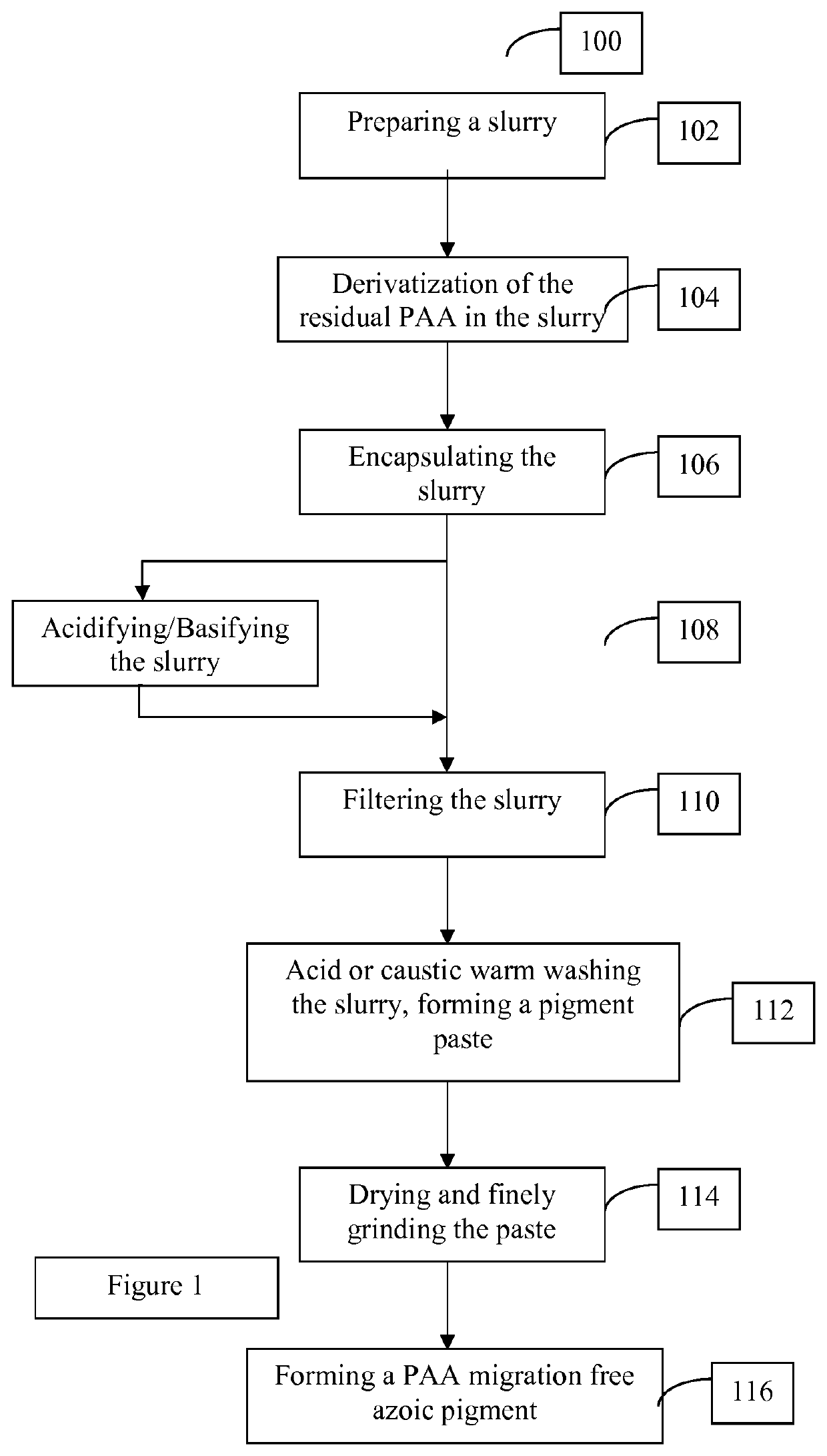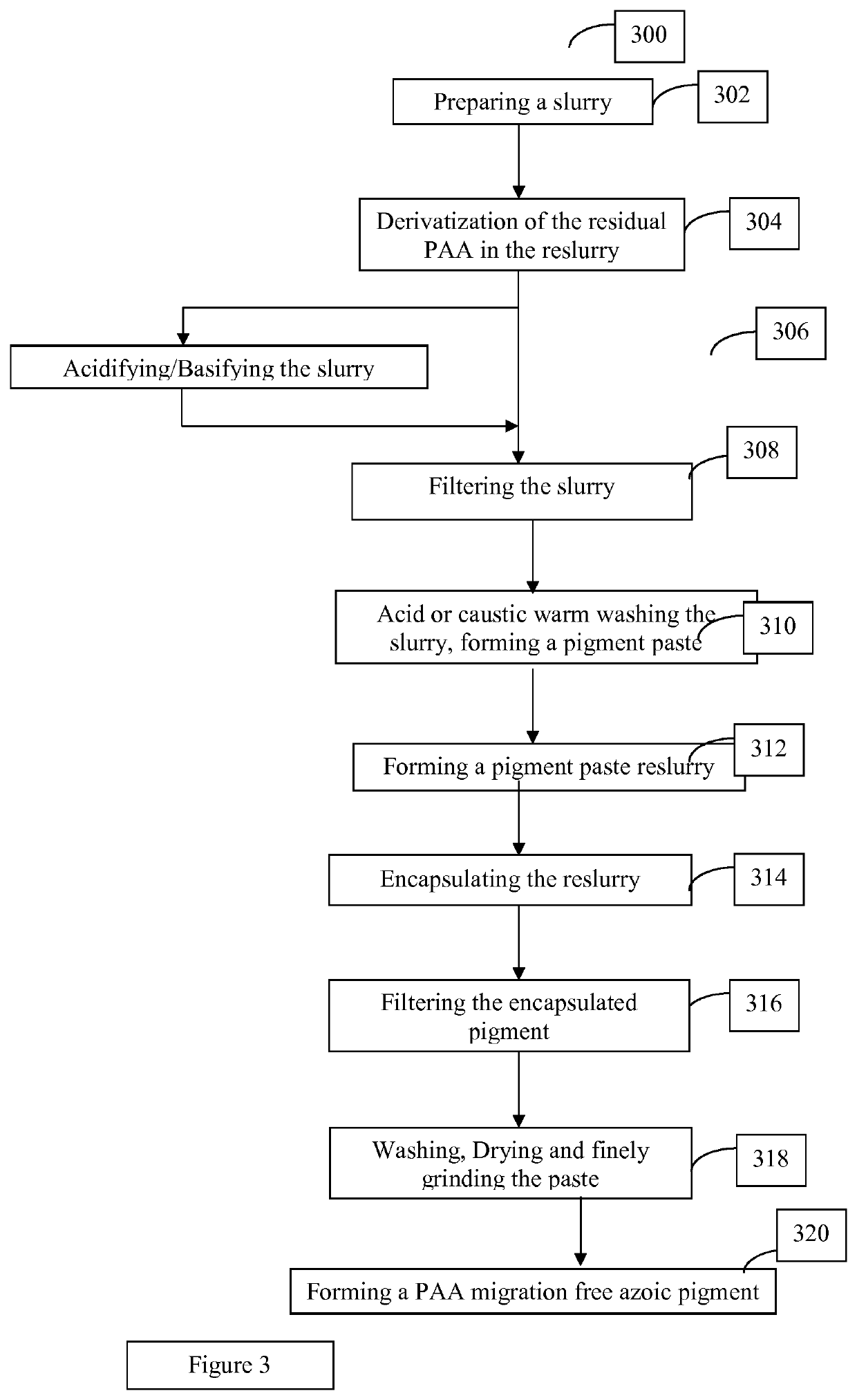Methods for manufacturing azoic pigments
a technology of azoic pigments and pigments, applied in the field of methods for manufacturing azoic pigments, can solve the problems of not having the required coloristic properties, affecting the end-consumer, and inability to cover the wide color space, so as to reduce the residual paa level, minimize the risk of paa migration, and reduce the content of paa
- Summary
- Abstract
- Description
- Claims
- Application Information
AI Technical Summary
Benefits of technology
Problems solved by technology
Method used
Image
Examples
example 11
thod of the Pigment in Water Based Ink
[0095]A liquid flexo-acrylic ink is prepared according to the following composition:
Joncryl 8078: 66%±0.01%
Isopropanol: 12%±0.01%
Tap water: 20%±0.01%
Propyleneglycol: 1%±0.01%
APMMEA: 1%±0.01%
[0096]The pH of the flexo-acrylic ink is adjusted between pH 9 and 9.2 with a concentrated aqueous ammonia solution. For each pigment prepared according to the examples above, 2 inks are prepared (sample and reference) according to the table below:
[0097]
ComponentWeightGlass beads30.00 ± 1.00 gTitanium dioxide RHD2—Pigment 3.00 ± 0.001 gFlexo-Acrylic ink*** g*** = complement the pigment with Flexo-Acrylic ink to 30.00 g ± 0.01 g
[0098]The prepared inks are ground on a skandex type disperser for 60 minutes. Illustrations are prepared on Kromekote type paper using barcoater no. 2 at 12 μm wet film thickness. The resulting illustrations are coloristically evaluated with a spectrophotometer using a measuring angle of 10° and standard illuminant D65 for their CIELa*...
example 12
ree Amine Quantification on the Pigments
[0103]About 50 mg of the pigment is weighted to a precision of 0.1 mg in a glass flask. 20±0.2 g of glass beads are added, followed by 50 mL of LC / MS grade MeOH. The flask is shaken for 1 hour on a skandex type disperser. An aliquot of the extract is filtered through a 0.2 μm syringe filter. The filtered extract is diluted 10-fold with 100 mM ammonium formate buffer in MQ water. Analysis is preferably performed by UPLC / MS-MS on a BEH column (length=50 mm, diameter=2.1 mm) using a mobile phase gradient consisting of Milli-Q type water and LC-MS grade methanol at a total flow of 0.42 mL / min. The limit of quantification is 1 mg / kg pigment.
[0104]Table 3 summarizes the residual free aromatic amine on C.I. Pigment Yellow 13 synthesized in the above samples.
[0105]
TABLE 3residual PAA amount2,4-DCBdimethylanilineΣPAAexample(mg / kg)(mg / kg)(mg / kg)13333332191931010420205121261212
[0106]Table 4 summarizes the residual free aromatic amine on C.I. Pigment Red ...
PUM
| Property | Measurement | Unit |
|---|---|---|
| temperature | aaaaa | aaaaa |
| temperature | aaaaa | aaaaa |
| temperature | aaaaa | aaaaa |
Abstract
Description
Claims
Application Information
 Login to View More
Login to View More - R&D
- Intellectual Property
- Life Sciences
- Materials
- Tech Scout
- Unparalleled Data Quality
- Higher Quality Content
- 60% Fewer Hallucinations
Browse by: Latest US Patents, China's latest patents, Technical Efficacy Thesaurus, Application Domain, Technology Topic, Popular Technical Reports.
© 2025 PatSnap. All rights reserved.Legal|Privacy policy|Modern Slavery Act Transparency Statement|Sitemap|About US| Contact US: help@patsnap.com



